Guest Contribution by Dennis Foley
The reflections in your control room represents the sound of your room. What sound do you ideally want from your control room? Do you want all the direct sound or straight line sound from your speakers? Do you want to include the sound of the reflections from the room in your mix? If so, how much of the room sound do you want?
Room sound is reflections. Reflections from your room walls, floor, ceiling, and rear wall are all part of the sound of the room. It is present in all rooms and must be managed correctly, if you are to hear all the sounds in your mix. Lets identify the problematic room boundary surfaces that produce these reflections.
The listening or monitoring position receives direct sound from your loudspeakers, which is the purest of all the sound energy you will hear. The direct or straight line sound contains no reflections and it is the reason that people sit near field in order to minimize room sound or reflections from the room boundary surfaces. Direct sound will produce the cleanest and purest signal. This signal will reveal all the sounds in the mix and is the desired sound for monitoring the content of your mixes no matter what the music genre.
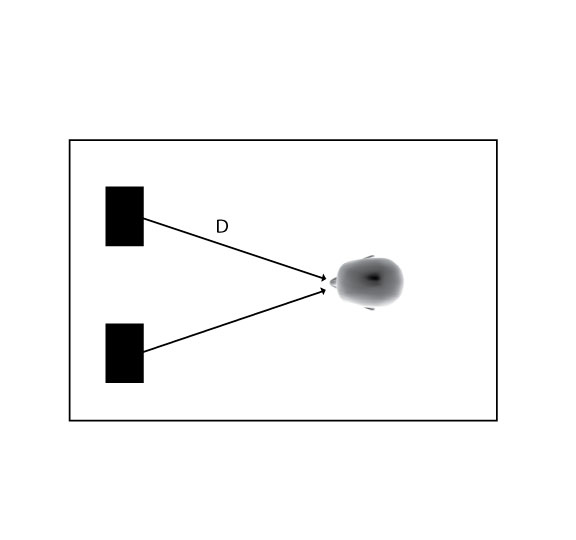
Small Rooms Are Reflections
Unfortunately, you must work in a room and most of us must work in small rooms. Small rooms produce large numbers of reflections. The wall surfaces in your small rooms are close together and produce many reflections that cross your monitoring or listening position. You are always fighting a battle between the reflections or room sound with your wanted or direct sound from your monitors. In order to minimize room sound, you must first identify the source of the reflection and then treat it with the proper room acoustic treatment. This process will allow for more of the direct or wanted sound to come through to the monitoring or listening position.
Ceiling / Floor Reflections
The first reflections to reach your ears from the room are the closet boundary surfaces to your listening or monitoring position. These are the reflections from the floor and ceiling. Floor and ceiling reflections arrive at the listening or monitoring position and then transverse across your direct or straight line sound from your monitors. These reflections are delayed in time from the direct sound from your monitors. This time delay produces room sound which must be treated in a manner that minimizes its impact at the listening position.
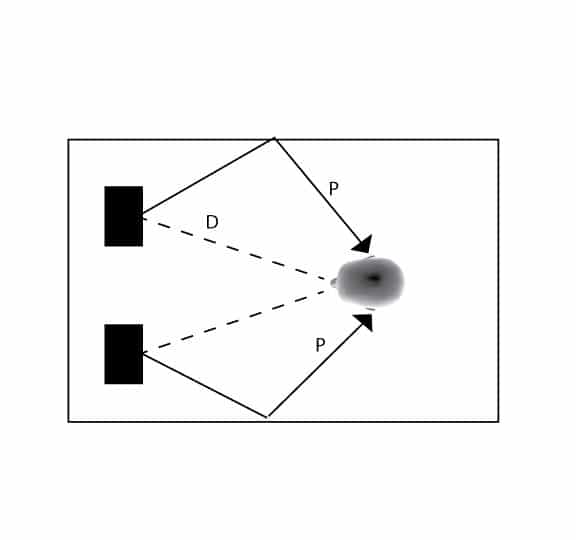
Side Wall Reflections
The next series of reflections or room sound that must be addressed is the side wall reflections. Left and right side wall reflections are next in line to cross your direct sound from your monitors. Side wall reflections from your room walls create a lateral sound issue that can impact the width of your sound stage and cause blurring and smearing of middle and high frequencies. The time delayed, side wall reflection can “imprint” its signature upon the direct sound from your speakers. Side wall reflections are the largest contributor to sonic issues within your mixes.
Rear / Front Wall Reflections
Rear and front wall reflections are the last to arrive at your listening or monitoring position. The rear wall time delayed signal causes havoc in any small room. It washes across the monitoring position and intermixes with the direct sound. It is sometimes referred to as the rear wall “slap echo” which it really is not an echo but a time delayed reflection. If it is serious enough to be given a name of its own, you can bet that it is an issue that everyone experiences in small room environments and must be dealt with to avoid the sonic issues it can cause within your mixes.
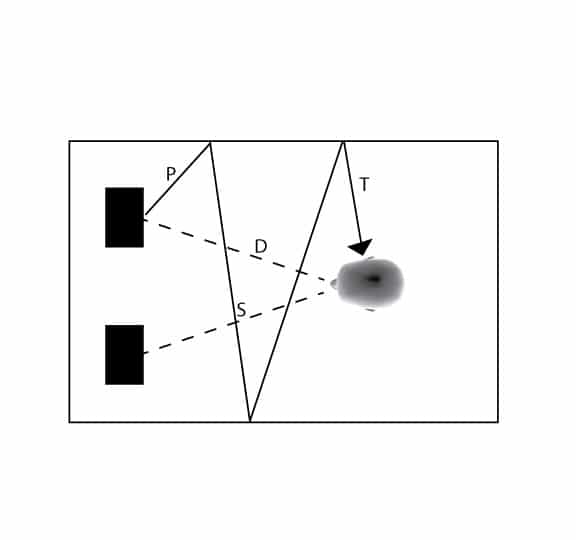
Treatment Options
What are the best treatment options for managing reflections from your room boundary surfaces? There are just two technology types that you can use for your small room environments. One is inexpensive and relatively easy to install and the other takes a bit more time and calculations. The two acoustic treatment technologies you can use are absorption and diffusion. Absorption is inexpensive and easy to install. Diffusion technology is more expensive and requires some understanding of how diffusion works in order to apply the correct diffusion for the room surface you are dealing with and trying to manage effectively.
Sound Diffusion
Diffusion takes the sound energy that strikes the wall surface and then redistributes that energy back into the room in a series of much smaller “reflections” if you will. Energy that strikes the wall surface enters the diffuser and is broken up into smaller amounts of energy that are then redistributed back into the room. There is no time delay or amplitude change in the diffused signal. The energy from the diffuser can be spread out evenly in a horizontal array or vertical pattern, depending on the positioning of the diffuser units within your room. Quadratic diffusion is the most used and time tested proven diffusion technology.
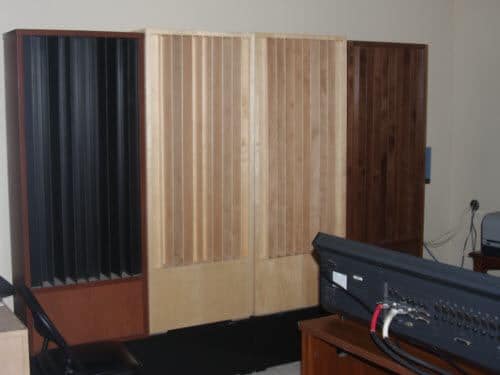
Quadratic diffusion
A quadratic diffuser is a series of wells or troughs that correspond to a prime number plugged into a formula to calculate the depth of each well or trough in the diffuser. Each well or trough diffuses energy following the quarter wavelength rule. This rule states that if the well depth is 25 % of the length of the frequency or frequencies to be diffused then diffusion at those frequencies will be produced. A vertically positioned quadratic diffuser, diffuses energy in a horizontal domain while a horizontally positioned diffuser diffuses energy in a vertical domain. Thus, with quadratic diffusion, you can have two out of a possible 3 dimensions of sound diffusion.
Quadratic diffusers can be designed to diffuse different frequency response ranges. As a general rule, the deeper the wells of the diffuser the lower the frequency of diffusion. Quadratic diffusers require a certain amount of distance in order for the diffused wave form to fully develop. Care must be taken to make sure the diffusion frequency response choice fits with the room size and listening or monitoring position. Diffusers can be located on side and front walls along with the ceiling to manage and reduce the impact of reflections from those surfaces. The rear wall of most small rooms needs diffusion, since this is the best way to minimize the slap back at the monitoring position from the rear wall without losing energy through the absorption process.
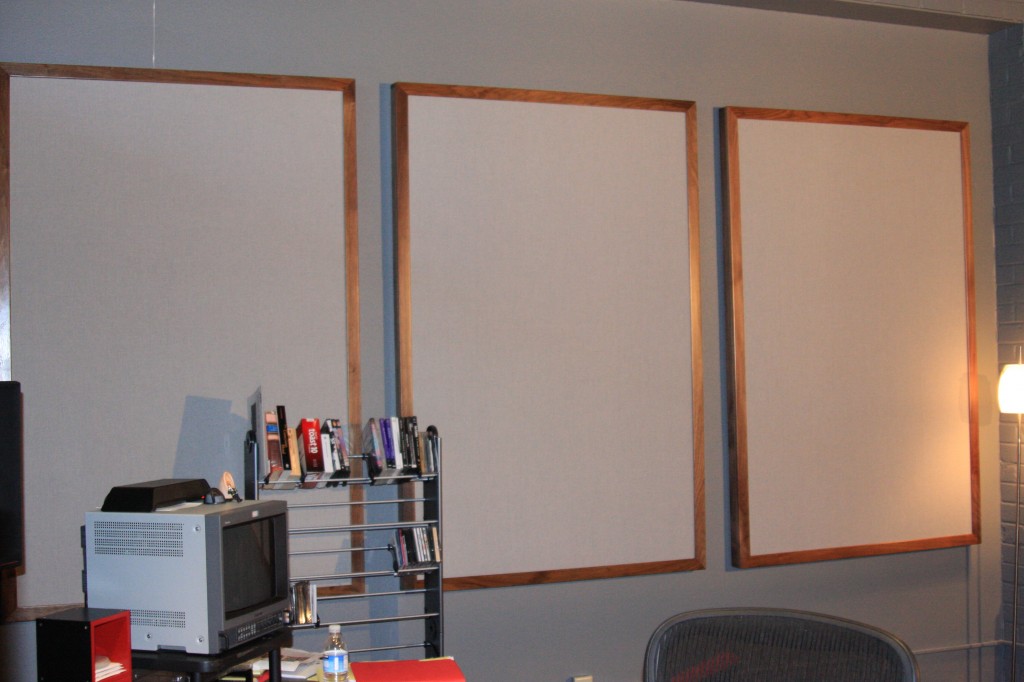
Sound Absorption Technology
The most economical and easy to install acoustical treatment for sound absorption is open celled acoustic foam. Foam comes in many shapes and sizes and it is relatively inexpensive when you compare it to sound diffusion, which is our other choice when it comes to reflection management in small rooms. Not all foams are created equal though and most have different rates and levels to their absorption curves.
A lot of foam manufacturers will tell you that their foam is best because it absorbs 100 % of everything. Absorbing 100 % of anything, except low frequencies, is never a good idea. You do not want to loose energy in order to manage it through the process of absorption which changes acoustical energy into heat. Foam absorption curves should be smooth and gradual in their absorption abilities and not overly absorb any one frequency range. We have all been in rooms that are overly absorbed. They are called “dead’ rooms for a good reason. All the life of the music has been drained through over absorption.
Diffusion / Foam
Reflections from your small room surfaces are called room sound. Room sound may be wanted and may not be in your mixes. It depends on what you are trying to accomplish with your music process. Most of the time you want to minimize room sound, so that you can hear everything going on within the mix. You do not want to have to try and figure out what is room sound and what is real vocals or music. To manage reflections within your small rooms, we have two choices of acoustical room treatment. We have diffusion and sound absorbing foams. Diffusion is more expensive and does require some calculations based upon room size and seating position. Sound absorbing foams are relatively inexpensive and easy to install.
For that reason we are happy to provide Designing Sound readers with a 25% discount offer on our Acoustic Foam. This offer is available until the 31st May 2014. Simply use coupon code designingsound2014 at the checkout.
About Dennis Foley
I am an acoustic engineer with over 30 years experience in the business and owner of www.acousticfields.com. My technology has been used in Electric Lady Land Studios, Sony Music of New York, Cello Music and Films founded by Mark Levinson, and Saltmines Studios in Mesa, Arizona, along with hundreds of others.
For free room acoustic treatment tutorials and techniques please sign up to my mailing list and you’ll instantly receive my free ebook “Free Space Listening – Listen to the Music Without Hearing the Room!” Sign up to the Acoustic Fields Mailing List here
Acoustic Fields Facebook Page
Acoustic Fields You Tube Channel
Thanks for the great article Shaun!!
Thank Dennis Foley. ;)